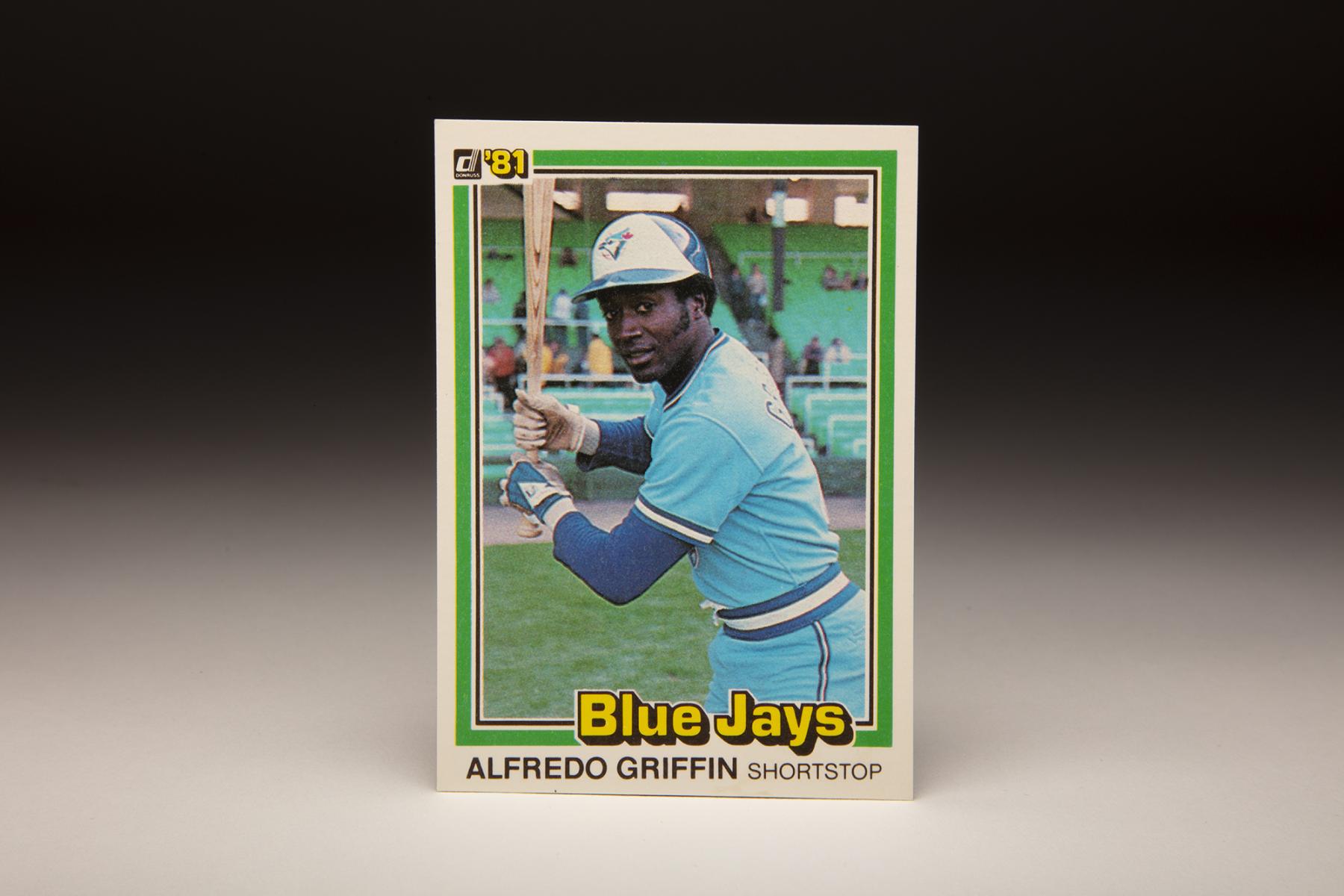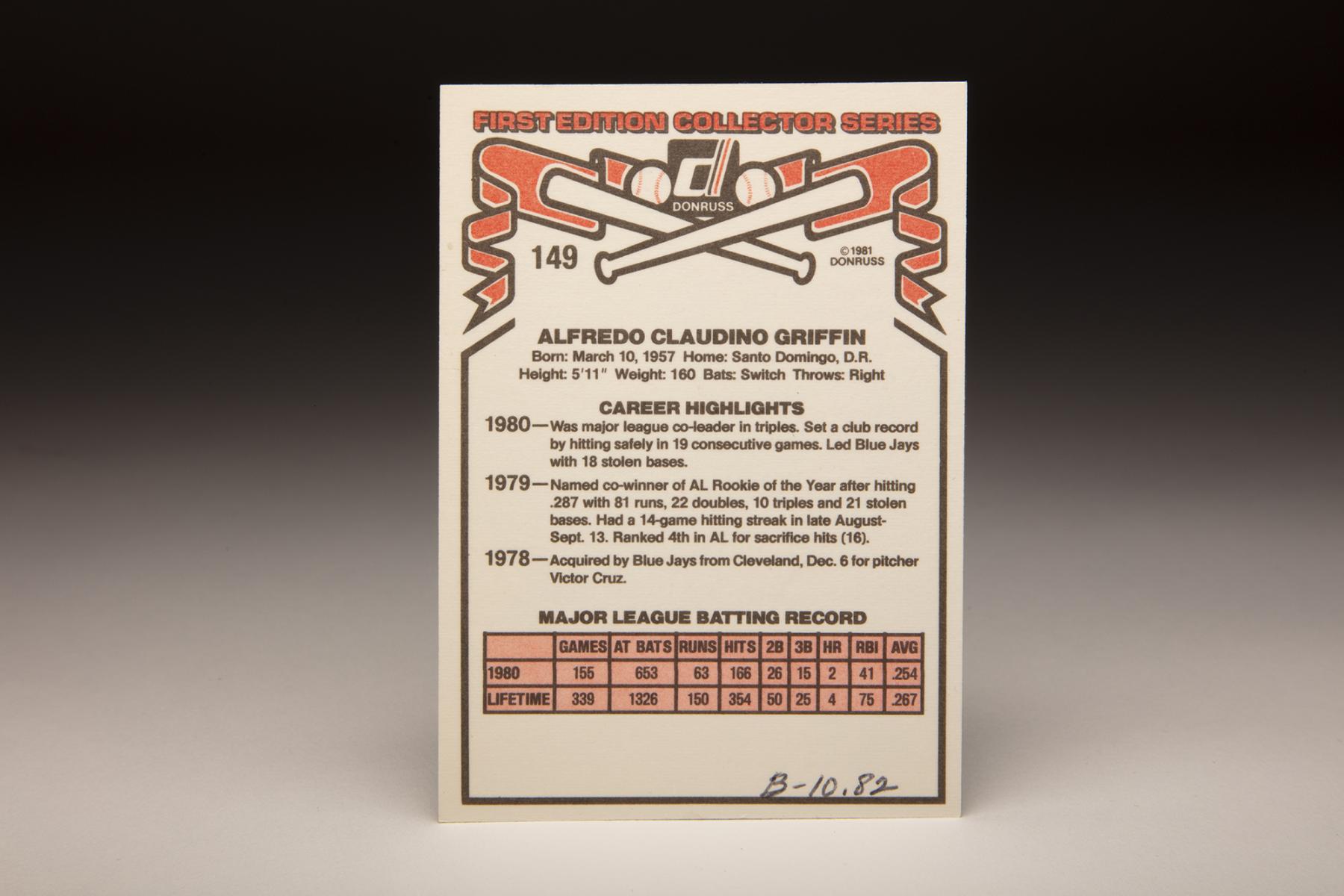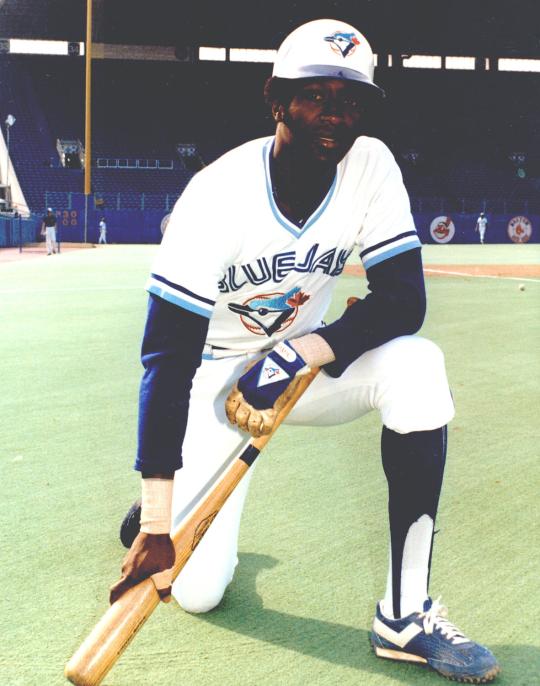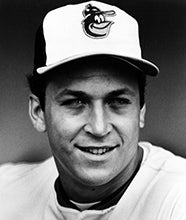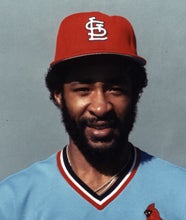- Home
- Our Stories
- #CardCorner: 1981 Donruss Alfredo Griffin
#CardCorner: 1981 Donruss Alfredo Griffin
At 5-foot-11 and 160 pounds, Alfredo Griffin hardly looked the part of a baseball ironman. Yet Griffin’s durability at shortstop is comparable to only a few players ever at the position – including Cal Ripken Jr.
As one of the first of many shortstops from San Pedro de Macoris in the Dominican Republic, Griffin helped blaze a trail for subsequent infielders from that town like Rafael Ramírez, Tony Fernández, Julio Franco, Juan Samuel and Mariano Duncan. And after helping the Blue Jays go from expansion team to American League powerhouse, Griffin would settle into a veteran role that brought him four World Series rings – including one as a coach.
In two of those Fall Classics, Griffin was connected with a pair of the most famous home runs in history.
Born Oct. 6, 1957, in Santo Domingo, Griffin was raised in San Pedro de Macoris by working-class parents whose blended family included six children. The Dominican government built three stadiums as replicas of Miami Stadium in the 1950s, one of which was in San Pedro. As a result, baseball became the sport of choice for thousands of athletes looking to move on from a life working in sugar cane fields and mills.
“We were poor. Baseball is one of a few things (children) can do down there,” Griffin told United Press International.
Official Hall of Fame Merchandise
Hall of Fame Members receive 10% off and FREE standard shipping on all Hall of Fame online store purchases.
Signed by the Cleveland Indians as an amateur free agent on Aug. 22, 1973, Griffin began his pro career as a 16-year-old with the Indians’ Gulf Coast League team in 1974 before earning a late-season promotion to Class A Reno of the California League.
In 1975, Griffin spent the entire season with San Jose of the California League, hitting .229 in 124 games but impressing scouts with his range at shortstop while making 47 errors in the field.
Griffin began the 1976 campaign back at San Jose but quickly worked his way to Double-A Williamsport and then to Triple-A Toledo, finishing the year with a .258 batting average in 144 games, including 132 hits and 22 stolen bases. A natural right-handed batter, Griffin started switch-hitting that season to take advantage of his speed.
Griffin also committed 48 errors but accepted a remarkable 657 chances in the field.
The Indians brought Griffin to the big leagues after the Triple-A season ended, and at 18 Griffin made his debut on Sept. 4. He was the youngest player to appear in a big league game that season.
Longtime Williamsport manager John “Red” Davis, who made it to the majors in 1941 as a third baseman with the New York Giants, told the Boston Globe that Griffin was the best shortstop prospect he had ever managed in the minors.
Griffin returned to Triple-A in 1977, hitting .249 and stealing 26 bases for the Mud Hens. He earned 12 starts with the Indians in September as Cleveland gave him an extended look-see, but hit just .146 and found himself back in Triple-A the next season – this time in Portland, Ore. – after reporting to Spring Training four days late due to visa issues and falling behind in the competition against veterans Larvell Blanks and Tom Veryzer.
“It wouldn’t bother me,” Griffin told the Associated Press of the prospect of being sent back to Triple-A. “It would just be more experience. Whatever they do with me is all right.”
Griffin hit .291 and stole 35 bases for the Beavers, but appeared in only five games with the Indians that September. On Dec. 5, 1978, the Indians traded Griffin and former first-round draft pick Phil Lansford to the Blue Jays in exchange for young reliever Víctor Cruz, who was 7-3 with a 1.71 ERA in 32 games for Toronto in 1978.
But Cruz pitched only two seasons for the Indians and worked in only 39 big league games after the 1980 season. Griffin, meanwhile, became a mainstay at shortstop for the Blue Jays for six years.
“We are future-oriented,” Blue Jays general manager and future Hall of Famer Pat Gillick told the Associated Press following the trade. “A number of clubs were interested in Cruz, but we wouldn’t have traded him unless we could get two players like Griffin and Lansford.”
The same day as the Griffin trade, Gillick sent his 1978 starting shortstop – Luis Gómez – and Chris Chambliss to the Braves in a deal that brought Barry Bonnell, Joey McLaughlin and Pat Rocket to Toronto. The moved cleared a spot for Griffin, who took full advantage by winning the Opening Day job in 1979 en route to a season where he hit .287 while setting new team records with 179 hits and 21 stolen bases, earning a share of the American League Rookie of the Year honors with Minnesota’s John Castino.
“I was worried my first month, but I tried to relax,” Griffin told the Canadian Press, referring to his .184 batting average at the end of April that was boosted when he hit .301 over the season’s final five months – including a .347 mark in September when he was named the AL Player of the Month. “I never really thought about the award, but I remember (broadcaster) Tony Kubek coming up to me in Spring Training and saying he thought I would be the Rookie of the Year.”
Griffin made 36 errors in 1979 and followed that with 37 errors in 1980 while playing in 155 games and hitting .254 with a big league-best 15 triples, tying the AL record for most triples in a season by a switch hitter.
His range and durability made him one of the most recognizable shortstops of the era as the Blue Jays slowly assembled a team that would become a powerhouse in the second half of the decade.
“A kid like Alfredo comes along only a few times in a lifetime,” Blue Jays manager Bobby Mattick told UPI in 1980. “There’s no question in my mind that he can – and probably will – become the best shortstop in the American League in the next two to three years.”
Griffin’s batting average dropped to .209 in the strike-shortened season of 1981. He bounced back to a .241 mark in 1982 while appearing in 162 games – all at shortstop – and leading AL shortstops in errors for the fourth straight season. But he also led all of his contemporaries with 319 putouts while finishing second in assists with 479, 10 behind MVP Robin Yount of the Brewers.
In 1983, Griffin again appeared in 162 games – but unlike in 1982, five of them were at a position other that shortstop. Griffin hit .250 while helping Toronto to 89 wins, the first time in franchise history the Blue Jays finished over .500. His 25 errors were a full-season career-best.
The Blue Jays signed Griffin to a five-year contract worth in excess of $3 million.
“I don’t try to copy any other shortstops,” Griffin told UPI. “But even when I was playing (in the Dominican Republic), I admired (Mark) Belanger and Luis Aparicio.”
But with heralded shortstop prospect Tony Fernández – who was also from San Pedro de Macoris – making his big league debut in 1983, Griffin’s days in Toronto were numbered. He appeared in a full-season career-low 140 games in 1984, earning his first All-Star Game berth but slowly ceding time to Fernández at shortstop as the year progressed. In September, Fernandez started 18 games at short while Griffin appeared mostly as a defensive replacement or at second base.
On Dec. 8, 1984, the Blue Jays sent Griffin and outfielder Dave Collins to the Athletics in exchange for pitcher Bill Caudill. It was the kind of deal the A’s had sought for years – as 19 players had appeared in a game at shortstop in the eight years following Bert Campaneris’ departure after the 1976 season.
“He has so much range, it’s unbelievable,” Oakland third baseman Carney Lansford told the San Francisco Examiner in Spring Training of 1985. “I’m glad he won’t be robbing me anymore.”
Griffin appeared in each one of Oakland’s 162 games at shortstop in 1985, hitting .270 with a career-high 64 RBI and winning his first Gold Glove Award.
“He has a great attitude,” Athletics coach Clete Boyer said of Griffin in 1985. “And you know you can write his name in the lineup every day.”
In 1986, Griffin once again appeared in 162 games at shortstop. Ripken also appeared in the maximum amount of games at short that season – and for each player it was the third time they had played in 162 games at shortstop in one year. No player previously had ever reached the mark more than once.
Ripken would go on to total eight seasons with at least 162 games at short while compiling his record of 2,632 consecutive games played. Griffin would play in 358 straight games from Sept. 19, 1984 through April 30, 1987, before ending the streak when he returned to the Dominican to attend his father’s funeral.
Griffin thrived on the daily work, hitting .285 in 1986 with a career-best 33 stolen bases. He hit .263 with 60 RBI and 26 steals in 1987, but a jammed thumb suffered while diving into first base limited him to pinch-running duty for the final two weeks of the season as the A’s faltered down the stretch, finishing four games behind the first-place Twins in the AL West.
Then on Dec. 11, 1987, the Athletics sent Griffin to the Dodgers as part of a three-team trade, opening up shortstop for prospect Walt Weiss. The deal brought Bob Welch to Oakland, Kevin Tapani to the Mets and Jesse Orosco to the Dodgers. It would set the stage for a memorable 1988 season, where the A’s and Dodgers would meet in the World Series.
“This guy plays 162 games a year,” Dodgers manager Tommy Lasorda told the Los Angeles Times following the trade. “This guy here, I’m telling ya, plays baseball like my wife shops: All day long!”
But on May 21 – after playing in each of the Dodgers’ first 38 games – Griffin suffered a broken right hand when he was hit by a pitch from the Mets’ Dwight Gooden. The injury sidelined Griffin until July 25, and during his absence Dave Anderson hit .265 and kept the Dodgers in the National League West race.
But Lasorda put Griffin back in the lineup down the stretch, and though Griffin hit only .199 on the season, his veteran presence helped Los Angeles win the division crown.
“Griffin just never makes a mistake,” Dodgers coach Bill Russell, himself an All-Star shortstop, told the Los Angeles Times. “The pitchers see that and the infielders see that and everyone goes about their job more calmly.”
Griffin had four hits and three RBI in Los Angeles’ seven-game NLCS win over the Mets, Griffin’s first-ever taste of the postseason. But the Dodgers entered the World Series heavy underdogs against the A’s.
In Game 1, Griffin had a single and a walk but was lifted for pinch-hitter Mike Davis with two outs and no one on in the bottom of the ninth as Dennis Eckersley was one out away from wrapping up a 4-3 win. Davis drew a walk – setting up Kirk Gibson’s epic home run that gave Los Angeles a 5-4 win and the momentum to win the championship.
Griffin had three hits and committed just one error while playing every inning in the field at shortstop for the Dodgers. He signed a new two-year contract following the season with $2 million.
Griffin hit .247 in 136 games in 1989 but slumped to a .210 average in 1990 in 141 games – his final season as a regular. He started the Dodgers first 90 games of the season until a fracas in a Pittsburgh bar left Griffin with an eye injury that put him on the bench for six games.
The Dodgers brought Griffin back in 1991, but he appeared in only 109 games while battling injuries and losing playing time to top prospect Jose Offerman. With Offerman ready for the big leagues, the Dodgers allowed Griffin to become a free agent.
“I’ll keep playing until they tell me I can’t,” Griffin told the San Bernardino County Sun. “But hopefully I’m the one who’s going to make the decision.”
Now 34, Griffin returned to the Blue Jays on a minor league deal and settled into a role as a reserve infielder. He hit .233 in 63 games, helping Toronto win the AL East and defeat Oakland in the ALCS to advance to the World Series for the first time. Griffin appeared in two World Series games as a defensive replacement – and was on the field at shortstop when the Blue Jays clinched the title in the bottom of the 11th inning against the Braves.
Toronto brought Griffin back in 1993 via arbitration, and Griffin reprised his role by hitting .211 in 46 games off the bench. Once again, the Blue Jays won the World Series – with Griffin appearing in three games as a defensive replacement. He was the next scheduled batter for Toronto when Joe Carter homered in the bottom of the ninth inning of Game 6 against the Phillies to win the championship.
Griffin retired in the spring of 1994. When he was introduced at Opening Day as the Blue Jays received their World Series rings, the fans at SkyDome gave their loudest cheers for Carter, Roberto Alomar and Griffin.
Griffin returned to the Blue Jays as a coach in 1996 and 1997 before joining former Dodgers teammate Mike Scioscia’s staff on the Angels in 2000. He remained with the Angels as a first base coach through the 2018 season, helping the team win the 2002 World Series and advance to the postseason seven times.
In 18 seasons as a big league player, Griffin hit .249 with 192 stolen bases and 1,688 hits. Among shortstops in the 1980s, only Ozzie Smith appeared in more games than Griffin.
“You have to love this game,” Griffin told the Los Angeles Times. “No reason you can’t play 162 games a year. Or, maybe not 162, but 160.”
Craig Muder is the director of communications for the National Baseball Hall of Fame and Museum
Related Stories
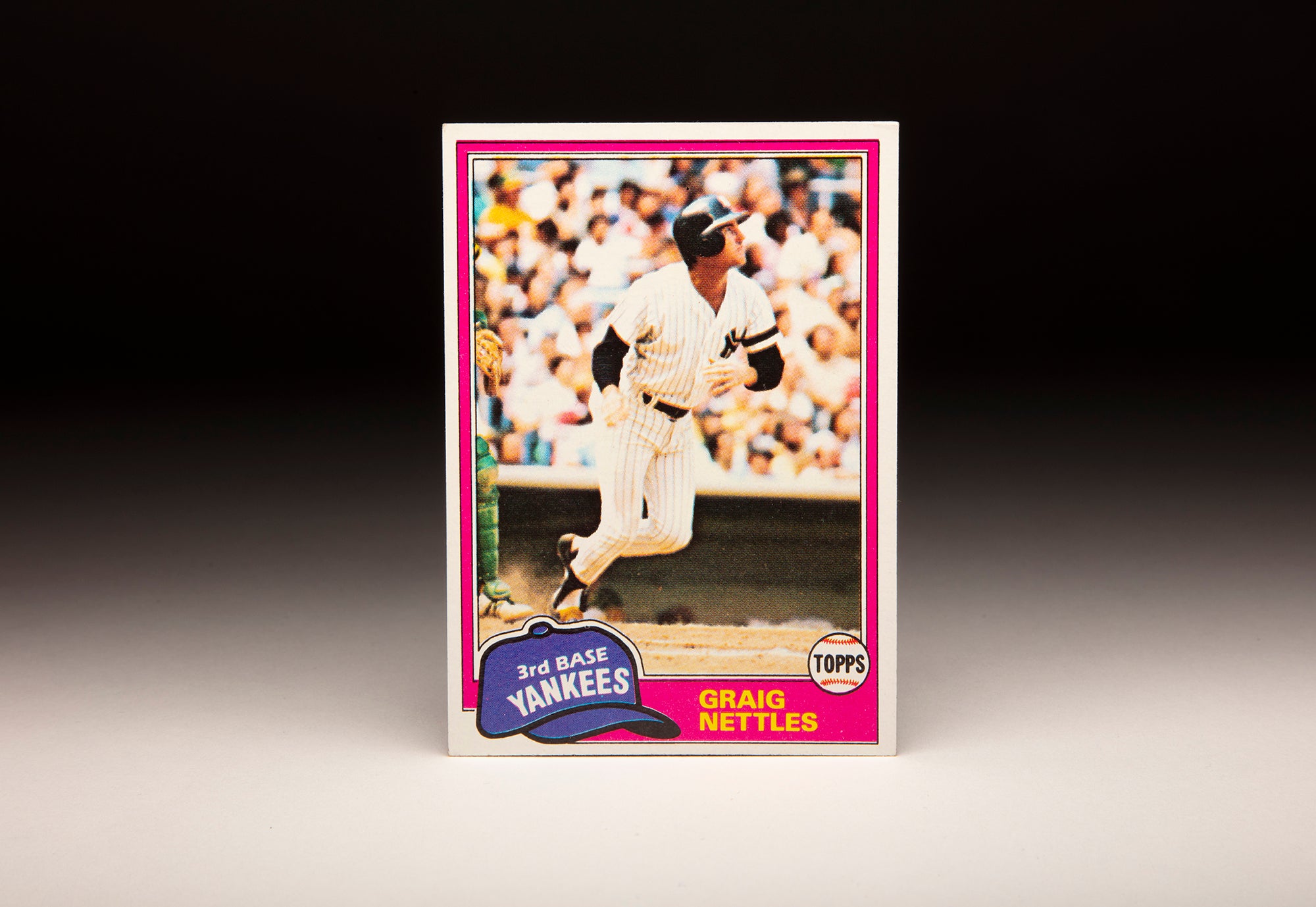
#CardCorner: 1981 Topps Graig Nettles
#CardCorner: 1981 Topps J.R. Richard
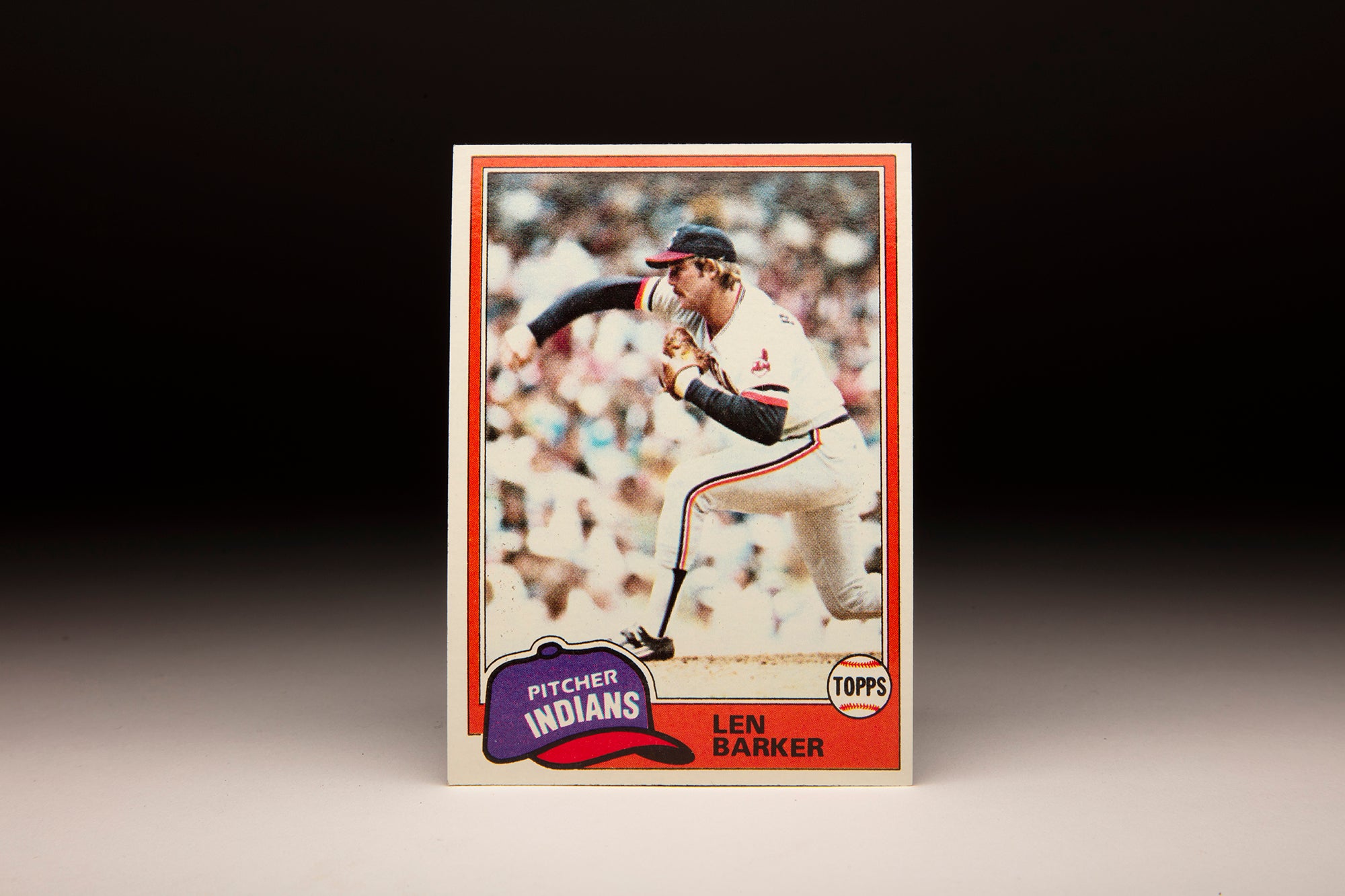
#CardCorner: 1981 Topps Len Barker
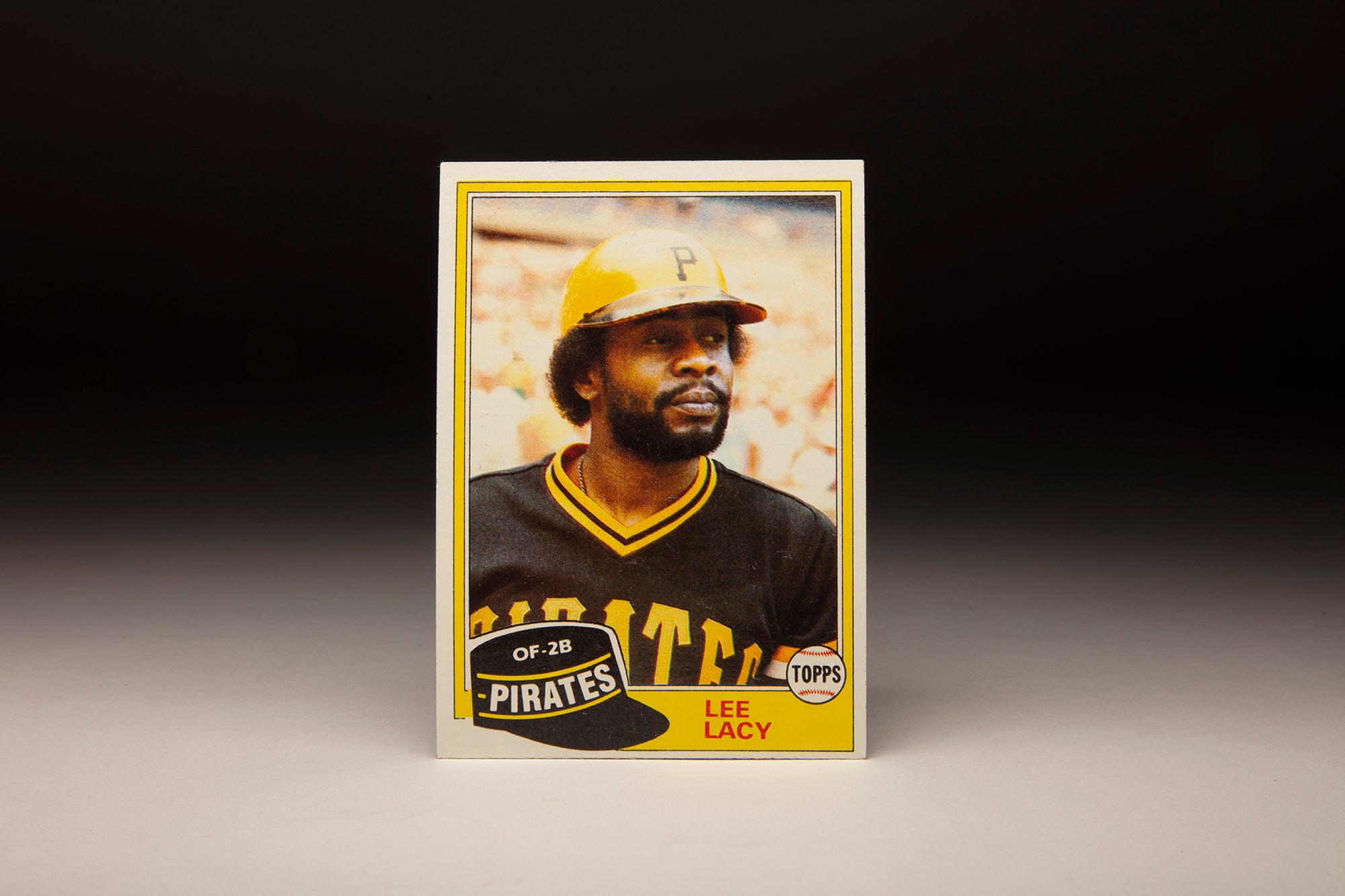
#CardCorner: 1981 Topps Lee Lacy

#CardCorner: 1981 Topps Graig Nettles
#CardCorner: 1981 Topps J.R. Richard

#CardCorner: 1981 Topps Len Barker


